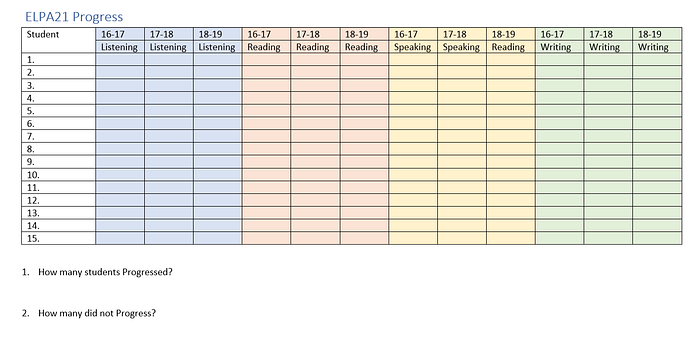by Monica Hulubei Piergallini, NBCT
We are now halfway through the 18–19 school year, the first school year of full implementation of ESSA, which has highlighted English Learners (ELs) both in academic proficiency, growth, AND language progress. To those schools that have a large demographic of ELs these data sources have been a priority for some time. Districts and schools just beginning to benefit from the growth in the population of ELs may still be learning the link between school success and these data. Here are a few actionable strategies to effectively use these data sources to guide responsive practices.

Progress Monitoring ELs Language
Summative data, such as Washington School Improvement Framework (WSIF) is not designed to be a surprise. Teachers, administrators, and district office should be aware of their summative scores before they are published by OSPI. With this in mind, how do your different levels within the district track EL progress?
At the classroom level:
If there is an additional English Language Development (ELD) teacher supporting the student, its essential both ELD teacher and classroom teacher are in regular collaboration. Why? What are we progress monitoring? The best way to progress monitor is to use the standards with which we are assessing, and the standards ELPA21 assess are the English Language Proficiency Standards (ELPS), which correspond closely to Common Core State Standards (CCSS) and the Mathematical and Science and Engineering Practices. Thus, with focused attention and collaboration on what is occurring in the classroom and ELD lesson we can collect great benchmarks to assess progress towards language proficiency, as measured by the ELPS.
What to do
Prepare for next school year by prioritizing support and planning time between ELD and classroom teachers. Consider how your master scheduling process can support this process. Plan on collecting several EL work samples throughout the year; one in fall, winter, and before the ELPA21 annual assessment. Assess the samples according to the corresponding ELPS. This can easily be found by knowing your CCSS, Mathematical or Science and Engineering Practice and then use the Matrix within the ELPS document to find the corresponding ELPS. Ask yourself and record per student, if there was growth per domain: reading, writing, listening, and speaking, as compared to their previous ELPA21 domain score. This will give you an idea if this student made “EL Progress”. The goal is to assist teachers in making sense of this new measure and to see its value.
Resources
- ELP Standards with Correspondences http://k12.wa.us/MigrantBilingual/ELD.aspx
- Understanding Language initiative modeling this same process http://www.k12.wa.us/MigrantBilingual/Module5/#01_GuidingQuestionsObjectives
- Reviewing ELPA21 Scores http://k12.wa.us/OSSI/SchoolImprovement/Webinars.aspx
At the school level:
First, provide time for teachers to accomplish the task above. Second, when ELPA21 scores are released, have teachers compare these results with the year prior, by domain. For example, look at a particular EL’s domain’s score from 17–18 to 18–19. Recording these scores on a table, will show exactly those students that made progress or went down in their score, per domain. This will lead to not only great instructional reflections, but also assist teachers in understanding ESSA EL Progress requirements.
What to do
- Create a table where teachers can compare two years of ELPA21 data, by domain. Schedule the time to analyze this important data.

- Understand the EL Progress requirements (Additional Resources tab) and your own Washington School Improvement Framework data in regards to EL http://reportcard.ospi.k12.wa.us/SchoolIndex_2018.aspx?groupLevel=District&schoolId=1&reportLevel=State&yrs=2016-17&year=2016-17
At the district level:
Assure your administrators understand this new ESSA measure and take the time to talk to their staff about it.
